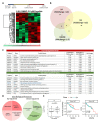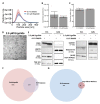Ergolide mediates anti-cancer effects on metastatic uveal melanoma cells and modulates their cellular and extracellular vesicle proteomes
- PMID: 37981907
- PMCID: PMC10654492
- DOI: 10.12688/openreseurope.15973.2
Ergolide mediates anti-cancer effects on metastatic uveal melanoma cells and modulates their cellular and extracellular vesicle proteomes
Abstract
Background: Uveal melanoma is a poor prognosis cancer. Ergolide, a sesquiterpene lactone isolated from Inula Brittanica, exerts anti-cancer properties. The objective of this study was to 1) evaluate whether ergolide reduced metastatic uveal melanoma (MUM) cell survival/viability in vitro and in vivo; and 2) to understand the molecular mechanism of ergolide action.
Methods: Ergolide bioactivity was screened via long-term proliferation assay in UM/MUM cells and in zebrafish MUM xenograft models. Mass spectrometry profiled proteins modulated by ergolide within whole cell or extracellular vesicle (EVs) lysates of the OMM2.5 MUM cell line. Protein expression was analyzed by immunoblots and correlation analyses to UM patient survival used The Cancer Genome Atlas (TCGA) data.
Results: Ergolide treatment resulted in significant, dose-dependent reductions (48.5 to 99.9%; p<0.0001) in OMM2.5 cell survival in vitro and of normalized primary zebrafish xenograft fluorescence (56%; p<0.0001) in vivo, compared to vehicle controls. Proteome-profiling of ergolide-treated OMM2.5 cells, identified 5023 proteins, with 52 and 55 proteins significantly altered at 4 and 24 hours, respectively ( p<0.05; fold-change >1.2). Immunoblotting of heme oxygenase 1 (HMOX1) and growth/differentiation factor 15 (GDF15) corroborated the proteomic data. Additional proteomics of EVs isolated from OMM2.5 cells treated with ergolide, detected 2931 proteins. There was a large overlap with EV proteins annotated within the Vesiclepedia compendium. Within the differentially expressed proteins, the proteasomal pathway was primarily altered. Interestingly, BRCA2 and CDKN1A Interacting Protein (BCCIP) and Chitinase Domain Containing 1 (CHID1), were the only proteins significantly differentially expressed by ergolide in both the OMM2.5 cellular and EV isolates and they displayed inverse differential expression in the cells versus the EVs.
Conclusions: Ergolide is a novel, promising anti-proliferative agent for UM/MUM. Proteomic profiling of OMM2.5 cellular/EV lysates identified candidate pathways elucidating the action of ergolide and putative biomarkers of UM, that require further examination.
Keywords: BRCA2 and CDKN1A Interacting Protein; Chitinase Domain Containing 1; Metastatic uveal melanoma; ergolide; extracellular vesicles.
Plain language summary
The most common form of adult eye cancer is uveal melanoma (UM). Once UM cancer cells spread to organs in the rest of the body, metastatic UM (MUM), there is a poor prognosis for patients with only one approved drug treatment. Hence, it is vital to better understand the cellular and extracellular proteins that regulate UM pathology in order to uncover biomarkers of disease and therapeutic targets. In this original study, we demonstrate a compound called ergolide is capable of severely reducing the metabolic activity and growth of UM cancer cells, grown as isolated monolayers. Ergolide was also able to reduce the growth of human MUM cells growing as tumors in transplanted zebrafish larvae. We identify that ergolide alters specific proteins found in the human UM cells. These proteins once analyzed in detail offer opportunities to understand how new treatment strategies can be developed for UM.
Copyright: © 2023 Sundaramurthi H et al.
Conflict of interest statement
No competing interests were disclosed.
Figures







Similar articles
-
1,4-dihydroxy quininib activates ferroptosis pathways in metastatic uveal melanoma and reveals a novel prognostic biomarker signature.Cell Death Discov. 2024 Feb 10;10(1):70. doi: 10.1038/s41420-023-01773-8. Cell Death Discov. 2024. PMID: 38341410 Free PMC article.
-
Uveal Melanoma Cell Line Proliferation Is Inhibited by Ricolinostat, a Histone Deacetylase Inhibitor.Cancers (Basel). 2022 Feb 3;14(3):782. doi: 10.3390/cancers14030782. Cancers (Basel). 2022. PMID: 35159049 Free PMC article.
-
High Cysteinyl Leukotriene Receptor 1 Expression Correlates with Poor Survival of Uveal Melanoma Patients and Cognate Antagonist Drugs Modulate the Growth, Cancer Secretome, and Metabolism of Uveal Melanoma Cells.Cancers (Basel). 2020 Oct 13;12(10):2950. doi: 10.3390/cancers12102950. Cancers (Basel). 2020. PMID: 33066024 Free PMC article.
-
Uveal melanoma modeling in mice and zebrafish.Biochim Biophys Acta Rev Cancer. 2024 Jan;1879(1):189055. doi: 10.1016/j.bbcan.2023.189055. Epub 2023 Dec 15. Biochim Biophys Acta Rev Cancer. 2024. PMID: 38104908 Review.
-
The application of natural compounds in uveal melanoma drug discovery.J Pharm Pharmacol. 2022 May 20;74(5):660-680. doi: 10.1093/jpp/rgac009. J Pharm Pharmacol. 2022. PMID: 35532546 Review.
Cited by
-
Assessment of ferroptosis as a promising candidate for metastatic uveal melanoma treatment and prognostication.Front Pharmacol. 2024 Oct 1;15:1466896. doi: 10.3389/fphar.2024.1466896. eCollection 2024. Front Pharmacol. 2024. PMID: 39411069 Free PMC article. Review.
-
Ergolide Regulates Microglial Activation and Inflammatory-Mediated Dysfunction: A Role for the Cysteinyl Leukotriene Pathway.Int J Mol Sci. 2025 May 23;26(11):5050. doi: 10.3390/ijms26115050. Int J Mol Sci. 2025. PMID: 40507859 Free PMC article.
-
Inhibition of Heme Oxygenase 1 Suppresses Growth, Migration, and Invasion, and Regulates Tumor-Infiltrating CD8+ T Cells and in Uveal Melanoma.Invest Ophthalmol Vis Sci. 2024 Aug 1;65(10):37. doi: 10.1167/iovs.65.10.37. Invest Ophthalmol Vis Sci. 2024. PMID: 39186260 Free PMC article.
-
Sesquiterpene lactones as emerging biomolecules to cease cancer by targeting apoptosis.Front Pharmacol. 2024 Mar 11;15:1371002. doi: 10.3389/fphar.2024.1371002. eCollection 2024. Front Pharmacol. 2024. PMID: 38529189 Free PMC article. Review.
-
1,4-dihydroxy quininib activates ferroptosis pathways in metastatic uveal melanoma and reveals a novel prognostic biomarker signature.Cell Death Discov. 2024 Feb 10;10(1):70. doi: 10.1038/s41420-023-01773-8. Cell Death Discov. 2024. PMID: 38341410 Free PMC article.
References
LinkOut - more resources
Full Text Sources
Molecular Biology Databases
Miscellaneous
